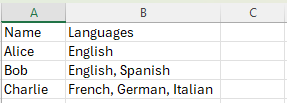
Cardinality
In our ongoing exploration of using the Semantic Engine to describe your data, there’s one concept we haven’t yet discussed—but it’s an important one: cardinality.
Cardinality refers to the number of values that a data field (specifically an array) can contain. It’s a way of describing how many items you’re expecting to appear in a given field, and it plays a crucial role in data descriptions, verification, and interpretation.
What Is an Array?
Before we talk about cardinality, we need to understand arrays. In data terms, an array is a field that can hold multiple values, rather than just one.
For example, imagine a dataset where you’re recording the languages a person speaks. Some people might speak only one language, while others might speak three or more. Instead of creating separate fields for “language1”, “language2”, and so on, you might store them all in one field as an array.
In an Excel spreadsheet, this might look like:

Written by Carly Huitema



